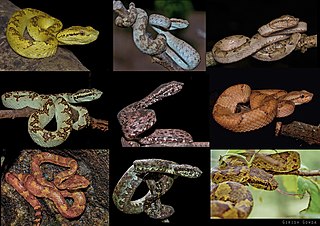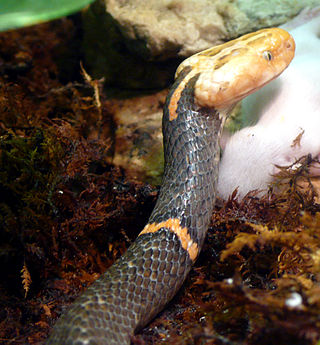Tropidolaemus huttoni is a little-known species of pit viper, a venomous snake in the subfamily Crotalinae of the family Viperidae. The species is endemic to the southern Western Ghats of India. There are no subspecies that are currently recognized. Little is known about this species, as this species is known only from two young individuals, based on which it was first described in 1949. Despite long-term and targeted herpetological surveys in the particular hill range (Meghamalai), it has never been re-sighted there or elsewhere since then.

Gloydius himalayanus also known as the Himalayan pit viper or the Himalayan viper is a pit viper species found along the southern slopes of the Himalayas in Pakistan, India and Nepal. No subspecies are currently recognized. Himalayan pit vipers have been found up to 4900m above sea level, which makes it the highest living snake ever found.

Craspedocephalusmalabaricus, commonly known as Malabar pit viper, Malabar rock pit viper, or rock viper, is a venomous pit viper species endemic to the high-moderate elevations of Western Ghats of southwestern India. Recently this species complex was split into three different species: C. malabaricus, C. travancoricus, and C. anamallensis.

Azemiopinae is a monogeneric subfamily created for the genus Azemiops that contains the viper species A. feae and A. kharini. They are commonly known as Fea's vipers. No subspecies are recognized. The first specimen was collected by Italian explorer Leonardo Fea, and was described as a new genus and new species by Boulenger in 1888. Formerly considered to be one of the most primitive vipers, molecular studies have shown that it is the sister taxon to the pit vipers, Crotalinae. It is found in the mountains of Southeast Asia, in China, southeastern Tibet, and Vietnam. Like all other vipers, they are venomous.

Tropidolaemus wagleri, more commonly known as Wagler's pit viper, is a species of venomous snake, a pit viper in the subfamily Crotalinae of the family Viperidae. The species is endemic to Southeast Asia. There are no subspecies that are recognized as being valid. It is sometimes referred to as the temple viper because of its abundance around the Temple of the Azure Cloud in Malaysia.

Gloydius halys is a pit viper species found within a wide range that stretches across Asia, from Russia, east of the Urals, eastwards through China. Five subspecies are currently recognized, including the nominotypical form described here.
Bamboo snake may refer to:

Bothriechis bicolor is a pit viper species found in southern Mexico, Guatemala and Honduras. The specific name refers to the contrasting ventral and dorsal colors. No subspecies are currently recognized.

Bothriechis aurifer is a pit viper species found in Mexico and Guatemala. No subspecies are currently recognized.

Craspedocephalus trigonocephalus, the Sri Lankan pit viper, Ceylon pit viper, Sri Lankan green pitviper or locally, pala polonga, is a venomous pit viper species endemic to Sri Lanka. No subspecies are currently recognized.

Craspedocephalus puniceus is a venomous pit viper species endemic to Southeast Asia. Common names include: flat-nosed pitviper, flat-nosed pit viper, and ashy pit viper. No subspecies are currently recognized.

Bothrops bilineatus, also known as the two-striped forest-pitviper, parrotsnake, Amazonian palm viper, or green jararaca, is a highly venomous pit viper species found in the Amazon region of South America. Two subspecies are currently recognized, including the nominate subspecies described here. A pale green arboreal species that may reach 1 m (3.3 ft) in length, it is an important cause of snakebite throughout the entire Amazon region.

Gloydius intermedius, or Central Asian pit viper, is a venomous species of pitviper endemic to northern Asia. Three subspecies are currently recognized, including the nominate subspecies described here.
Gloydius strauchi is a species of venomous pit viper in the subfamily Crotalinae of the family Viperidae. The species is native to western China. It is a small snake with a pattern of four longitudinal stripes, although some older specimens may be a uniform black. G. strauchi may be distinguished from G. monticola by its higher midbody dorsal scale count. This species jointly holds the altitude record for pitvipers together with Crotalus triseriatus of Mexico, both being found even above the tree line at over 4,000 m (13,000 ft). No subspecies were recognized as being valid, until a recent publication re-evaluated the taxonomic statuses of populations of G. strauchi and described the eastern Tibetan populations as a new species.

Bothriechis thalassinus, also known as Merendon palm-pitviper or Merendon palm pit viper, is a pit viper species native to Guatemala and Honduras.
Angus Finlay Hutton was a British naturalist born in India. Working in the High Wavy range, he discovered a species of pit viper that is now named after him as Hutton's pit viper. He also collected a species of bat that was later named as Salim Ali's fruit bat after Indian ornithologist Salim Ali. Until his death is 2016, Hutton was the oldest living member of the Bombay Natural History Society (BNHS). He helped set up butterfly gardens in Southeast Asia before settling in Queensland, Australia.

Tropidolaemus laticinctus is a species of venomous snake in the pit viper subfamily, Crotalinae. Its common names are Sulawesi pit viper,broad-banded temple pitviper, or broad-banded pit viper. It is endemic to the Indonesian island of Sulawesi.
Ophryacus smaragdinus is a pit viper species endemic to the mountains of eastern Mexico. No subspecies are currently recognized.

Trimeresurus salazar, also known as Salazar's pit viper, is a species of venomous, green pit viper first discovered in 2019 in the lowlands of the western part of Arunachal Pradesh, India; the fifth new reptile species to be discovered in the region in 2019. It was named after Salazar Slytherin from the Harry Potter series. It has a dark green head and yellowish green dorsal scales on the rest of its body. The species is sexually dichromatic; the males have reddish-orange and yellow-orange stripes and a rusty red-orange tail that the females lack. Its habitat is under threat from human development activities.
















